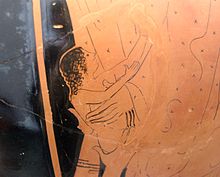Erichtonius of athens
Erichthonius (Greek Ἐριχθόνιος, Erichthónios), also called Erectheus I, was the first semi-mythical king of Athens (other sources say he was Cecrops I). The classic texts affirm that he was the son of Hefesto (Vulcano) and Attis or Átide, daughter of Cránao; according to other sources, daughter of Gea, They also affirm that she came from Sais (Egypt). In union with Praxitea, Ericthonius had Pandion.
According to the myth, when Hephaestus (Vulcan) tried to rape Athena (Minerva), who was looking for a weapon in her workshop, the semen fell on the goddess's thigh, and when she tried to take it from her, it impregnated the Earth (Gea), and from her Erechtheus I or Erictonio ('born of the earth') was born.
According to Pausanias, Athena put Ericthonius in a basket, which he gave to three sisters, named Aglauros, Herse and Pándroso. She forbade them to open it, but Herse and Aglauro disobeyed her and upon seeing Ericthonio, with the body of a serpent, they went mad and threw themselves off the steepest part of the Acropolis of Athens. He also says that Ericthonio could be the serpent carved next to the spear of Athena Parthenos, sculpted by Phidias and located in the Parthenon.
He was deified and a temple was erected for him in said city. The myth attributes many feats, warlike and cultural, to him. It is said that it was Ericthonius who introduced the cult of the goddess Athena (other sources say that it was Cécrope I) and who founded the festival or religious procession of the Panatheneas in 1506 BC. C., according to the Chronicle of Paros. He is also credited with inventing the horse-drawn carriage.
Fonts
- Library III, 14, 6.
- EURIPIDES: Ion 20 ss.; 266 ss.
- HIGINO: Fables.
- 166: Erictonio (Erichthonius).
- English translation, on Theoi site.
- Ed. of 1872 on the Internet Archive: Latin text, in electronic facsimile.
- English translation, on Theoi site.
- 166: Erictonio (Erichthonius).
- PAUSANIAS: Description of Greece i.18.2.
- OVIDIO: Metamorphosis II, 553-561.
- Trad. to Spanish, on Wikisource.
- Metamorphosis. Book II: Latin text, Wikisource.
- Trad. to Spanish, on Wikisource.
Contenido relacionado
Category:History of Guyana
Flag of Argentina
Luis de Carvajal y de la Cueva
